Little America
The forty-ninth parallel divides the United States from Canada from the Great Lakes to the Pacific, including Tsawwassen Peninsula, most of which belongs to Canada. Unless you arrive by boat, the only way into the Washington state town of Point Roberts is to drive across an international border--twice. The nine-hundred-odd premanent residents feel neither strongly tied toWhatcom county (whose seat is Bellingham) or to Canada. The town, with its beaches and excellent marina, has long been a favorite weekend vacation spot for Canadians, who sometimes refer to it as Little America. When it was illegal to drink on Sundays in Canada, the bars would be open in Point Roberts. When smoking in restaurants became illegal up north, restaurants in Point Roberts welcomed smokers. It was a liquor-running port during Prohibition. At the turn of the century, the fishing industry flourished, so much so that the fish did not, and, eventually, the industry went the way of the fish.
George Wright and Rose Momsen welcome
me
to their home and organic garden
The drive from Bellingham takes less than an hour, other than the wait at the border, at which point a man in a uniform asks where you are from, where you are going and why. On this particular day, the wait for this minor interrogation lasted half an hour. I spent the time listening to Cliff Lang's cassette of original songs, which he sent to me in Seattle. Lots of funny lyrics, flashy guitar solos, sound effects, unexpected concepts and general swashbuckling, plus Mary Keel's wonderful voice on some of the songs--the wait seemed almost too short. Trailing rock and roll like a scarf, I boogied on down to George and Rose's house, following a set of emailed directions over a set of roads I'd never seen before. This is my idea of a good time.

Three baby swallows, soon to learn to
fly, in the eves above
Rose and George's front door.
I met George when I first moved to Maui in 1974. Everything he created impressed me; carvings, buildings, music. He recorded a CD of original country music called Have You Hugged Your Cowboy Today? He married Rose in the 1980's, she, another renaissance person, a talented artist, teacher, and clothing designer. When I revised Living On The Earth, I consulted them both. They left Maui a couple of years ago, and, for a while, the only address I had for them was an email address. However, when I emailed them that I intended to drive through Washington state on my book tour, they invited me to visit them in their new home in Point Roberts. They bought a house already and began renovating it; Rose opened a quilting business; they started a not-for-profit arts organization with the idea of founding a center for art and music classes for adults and children in the community, and it has already put on two music festivals, with 6,000 attending the first year and 9,000 the second. Their organic garden is full of vegetables, and their hedges are full of blackberries. Life is good.
Rose had a full day's quilting to do, and George offered to take me on a tour of Point Roberts, an area of about five square miles, almost square in shape, and surrounded on three sides by water.

Light House Park, with the ruins of a wharf

Typical summer cottages in the South Beach area
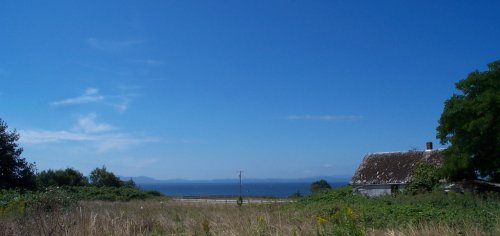
An old home overlooking the gulf and the San Juan Islands
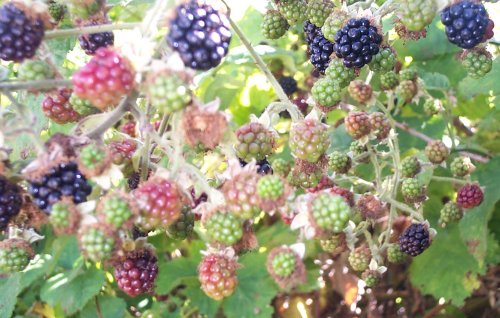
Blackberries are abundant at the entrance to the Lily Point Trail.
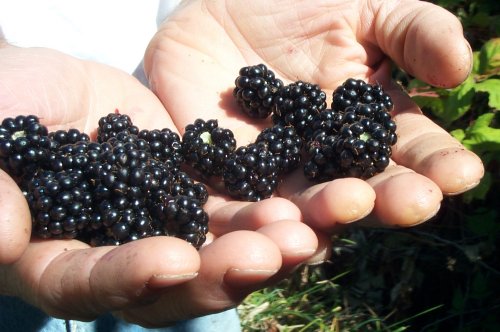
So, we stop for a little snack.
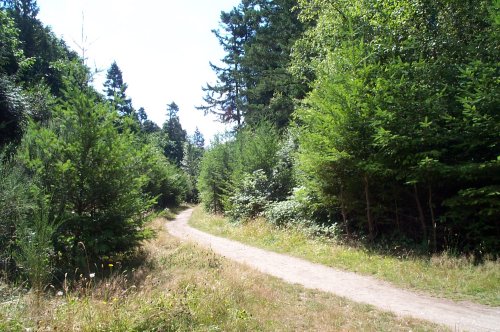
Lily Point trail--the most popular walking area in Point Roberts
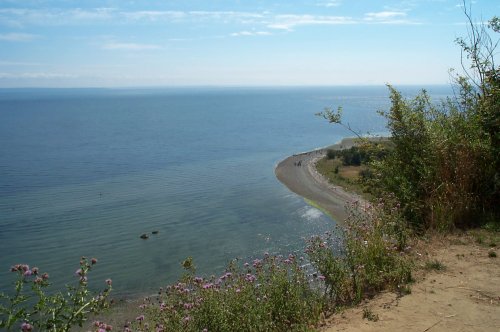
The view from the cliff at Lily Point. It's two hundred feet down to the ocean.
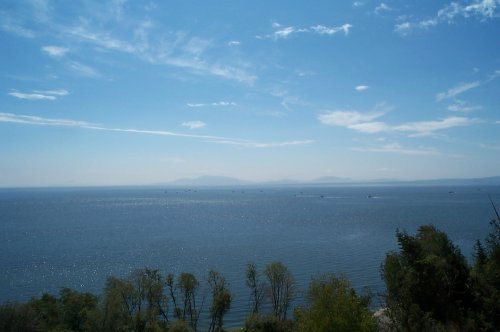
George was amazed to see fishing boats
in the channel between Point Roberts
and the San Juan Islands. He hadn't seen any in the time
he'd lived here.
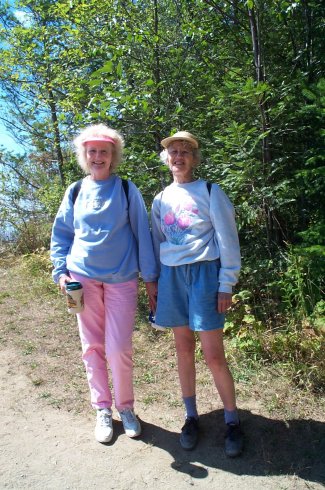
As if on cue, up the trail walked Helen
Fenwick-Sweet and
Janice Green, formerly the Thompson sisters, who grew up
in Point Roberts. Their father fished with a fleet;
they'd seen
the town boom and bust; both had married Canadians and
moved away.
They filled us in on local history, and were fascinated
by the work
George and Rose are doing in the community. Helen says
she will
bring the quilts her mother made to Rose for restoration.
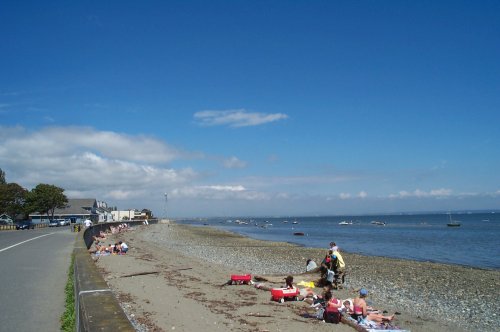
Maple Beach, at the north-east corner
of Point Roberts. The border is at the end
of the street. You have to go the one border station with
the guard to acually cross.
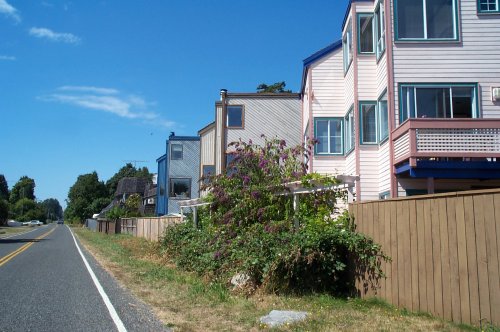
Apartments in Canadian Tzawwassen overlook a street in Point Roberts, USA

Summer homes by Maple Beach
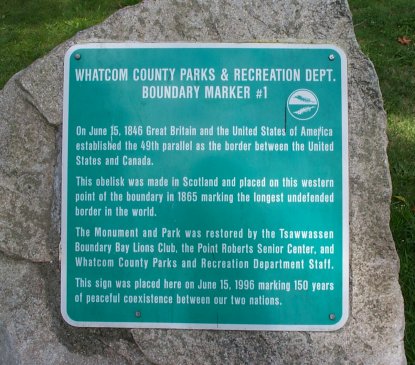
Plaque at Monument Park, the northwest
corner of Point Roberts,
the most northwest point of the Pacific Northwest.

The obelisk at Monument Park
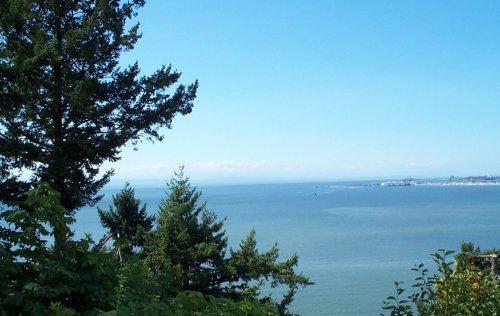
View from Monument Park. The wharf is for the ferry to Victoria.

Falling down log cabin with stone chimney
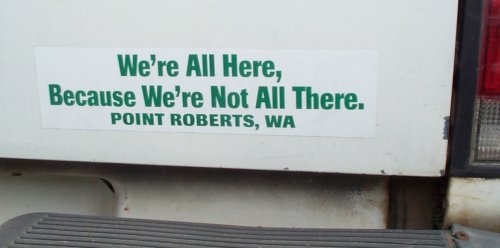
Bumper Sticker